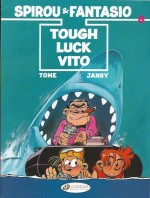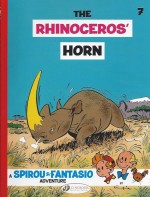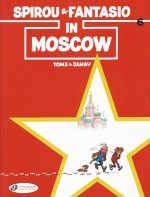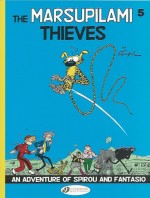
By Tome & Janry, colour by Stephane De Becker & translated by Jerome Saincantin (Cinebook)
ISBN: 978-1-84918-248-5
For the majority of English-speaking comics readers Spirou might be Europe’s biggest secret. The phenomenally long-lived character was a rough contemporary – and shrewdly calculated commercial response – to Hergé’s globally popular Tintin, whilst the fun-filled periodical he has headlined for decades is only beaten in sheer longevity and manic creativity by our own Beano.
Conceived in 1936 at Belgian Printing House Éditions Dupuis by boss-man Jean Dupuis, the proposed new enterprise homed in on juvenile audiences and launched on April 21st 1938; debuting neatly between DC Thomson’s The Dandy (4th December 1937) and The Beano (July 30th 1938) in the UK.
In America at that time a small comicbook publisher was preparing to release a new anthology entitled Action Comics. Ah, good times…
Spirou the publication was to be edited by 19 year-old Charles Dupuis and derived its name from the lead feature, which related improbable adventures of a plucky bellboy and lift operator employed at the glamorous Moustique Hotel (an in-joke reference to the publisher’s premier periodical Le Moustique).
Spirou the hero – whose name translates as both “squirrel†and “mischievous†in the Walloon language – was first realised by French cartoonist François Robert Velter under his pen-name Rob-Vel to counter the runaway success of Hergé’s carrot-topped boy reporter. Tintin had been a certified money-spinning phenomenon for rival publisher Casterman ever since his own launch on January 10th 1929 in Le Petit Vingtième, the kids’ supplement to Belgian newspaper Le Vingtième Siècle.
Spirou magazine premiered with the plucky bellboy and his pet squirrel Spip as the headliners in a weekly anthology which bears his name to this day; featuring fast-paced, improbable incidents which eventually evolved into high-flying, surreal comedy dramas.
Spirou and his pals have spearheaded the magazine for most of its life, with a phalanx of major creators carrying on Velter’s work, beginning with his wife Blanche “Davine†Dumoulin who took over the strip when her husband enlisted in 1939.
She was aided by Belgian artist Luc Lafnet until 1943 when Dupuis purchased all rights to the feature, after which comic-strip prodigy Joseph Gillain (“Jijéâ€) took over. In 1944 he introduced Fantasio as Spirou’s new best friend and companion-in-adventure: a blonde headed reporter with a quick temper, uncontrolled imagination and penchant for finding trouble.
In 1946 Jijé‘s assistant André Franquin assumed the reins, slowly sidelining the shorter, gag-like vignettes in favour of extended light-hearted adventure serials whilst introducing a wide and engaging cast of regulars.
He was succeeded by Jean-Claude Fournier who updated the feature over the course of nine stirring adventures that tapped into the rebellious, relevant zeitgeist of the times with tales of environmental concern, nuclear energy, drug cartels and repressive regimes.
By the 1980s the series seemed outdated and without direction so three different creative teams were commissioned to alternate on the serial, until settling at last upon Philippe Vandevelde writing as Tome and artist Jean-Richard Geurts AKA Janry.
Their winning approach was to carefully adapt, reference and, in many ways, return to the beloved Franquin era. These sterling efforts consequently revived the floundering feature’s fortunes, resulting in fourteen wonderful albums between 1984 and 1998.
This one, originally entitled Vito la Déveine from 1991, was their 11th collaboration and the 43rd collected exploit of the tireless wanderers, whose exploits have filled more than sixty albums, specials and spin-off collections.
With the customary cavalcade of gags soft-pedalled in favour of scintillating suspense and riotous action this tale commences with former Mafia mastermind Don Vito “Lucky†Cortizone (last seen in Spirou & Fantasio in New York and now known as “Tough Luck Vitoâ€) attacking his shady pilot Von Schnabbel after the unprincipled scoundrel tries to gouge the gangster for more money.
This is very bad idea as they are currently flying over the Pacific Ocean, ferrying the Don’s enigmatic “get-rich-again-quick†cargo, brazenly swiped from the Chinese Triads…
After kicking the conniving extortionist out of the plane, the infuriated Mafiosi is unable to prevent the craft crashing into a lagoon on a deserted atoll. At least there’s an abandoned hotel to shelter in and plenty of crabs to eat…
Months later Spirou and Fantasio are navigating stormy seas nearby in a sailing boat. Well, one of them is: Fantasio is too depressed and heartbroken over a girl he met in Tahiti to be of any use.
She was far more interested in the guy who rented them the good ship Antares and now the journalist is pining away his tragic existence, a soul-shattered, broken man…
As a result of the tropical typhoon the vessel is soon in a similar condition and barely limps into the shaded waters of an isolated lagoon. The shaken mariners are astounded to find the lovely isle surrounding it has a population of one: a ragged, skinny guy with a weird accent, hungry for food and companionship.
Physically Vito is unrecognisable and as the vessel limps into the sheltered, shark-infested waters he makes his plans to kill whoever’s aboard and sail away. As he laces the lush vegetation with deadly traps and pitfalls he thinks only of coming back and retrieving his precious cargo from the ocean floor.
Those plans swiftly alter when he realises that his rescuers are the interfering whelps who cost him his criminal empire…
They alter again after he walks into one of his own booby-traps and Spirou and Fantasio come to his aid. The do-gooders have no idea who he is and take him back to their boat to recuperate. Spirou even offers to dive down to the plane wreck and retrieve his cargo whilst they’re repairing the Antares’ damaged rudder…
Everything seems to be turning around for the hard-luck kid, but as he gorges on the ship’s stores and shaves, he soon starts to resume his former appearance and, after his first attempt to murder Spirou fails, the duplicitous Don opts for a more subtle revenge…
Drugging the sharp-witted red-haired lad, he then tells Fantasio who he is but claims his privations have made him a new, repentant and changed man. With Spirou apparently bedridden by “tropical feverâ€, Vito has the utterly gulled reporter finish salvaging the cargo in search of a spurious antidote supposedly packed in one of the sunken crates.
After all there’s plenty of time to kill them both once Vito has all his precious loot back…
Naturally things don’t quite work as he intended, but before our heroes can properly turn the tables on Tough Luck Vito, fate proves the aptness of his nickname when Von Schnabbel and the extremely put out original owners of the contentious cargo turn up, hungry for vengeance and not too worried about the odd case of collateral damage…
Swiftly switching from tense suspense to all out action, events spiral out of control and our now fully recovered heroes only need the right moment to make their move…
This kind of lightly-barbed, keenly-conceived, fun thriller is a sheer joy in an arena far too full of adults-only carnage, testosterone-fuelled breast-beating, teen-romance monsters or sickly sweet fantasy. Readily accessible to readers of all ages and drawn with all the beguiling style and seductively wholesome élan which makes Asterix, Lucky Luke and their ilk so compelling, this is another cracking read from a series with a stunning pedigree of superb exploits; one certain to be as much a household name as those series, and even that other pesky red-headed kid with the white dog…
Original edition © Dupuis, 1991 by Tome & Janry. All rights reserved. English translation 2015 © Cinebook Ltd.



